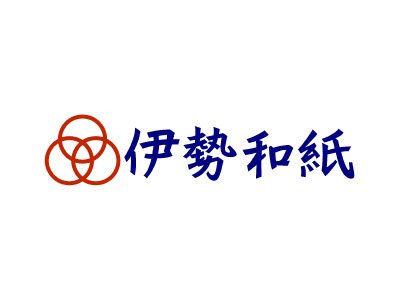HANDMADE ISEWASHI
Washi is made from barks of plants.
Pick up fibers from a bast inside an epidermis,
and carefully remove the impurity components from the fibers.
As the next step, beat and unravel the fibers,
and put them in a vat filled with water.
Scoop dispersed fibers from the vat with a deckle one by one.
Stretch a sheet formed by the screen on a plate to dry.
At last, beautiful washi with equal thickness is produced.
Depending on the use, the handmade IseWashi’s raw material is
blended Kouzo, Mitumata, Ganpi and/or Basewo
with thick liquid extracted from the roots of Tororoaoi
to disperse the fibers evenly in the water.
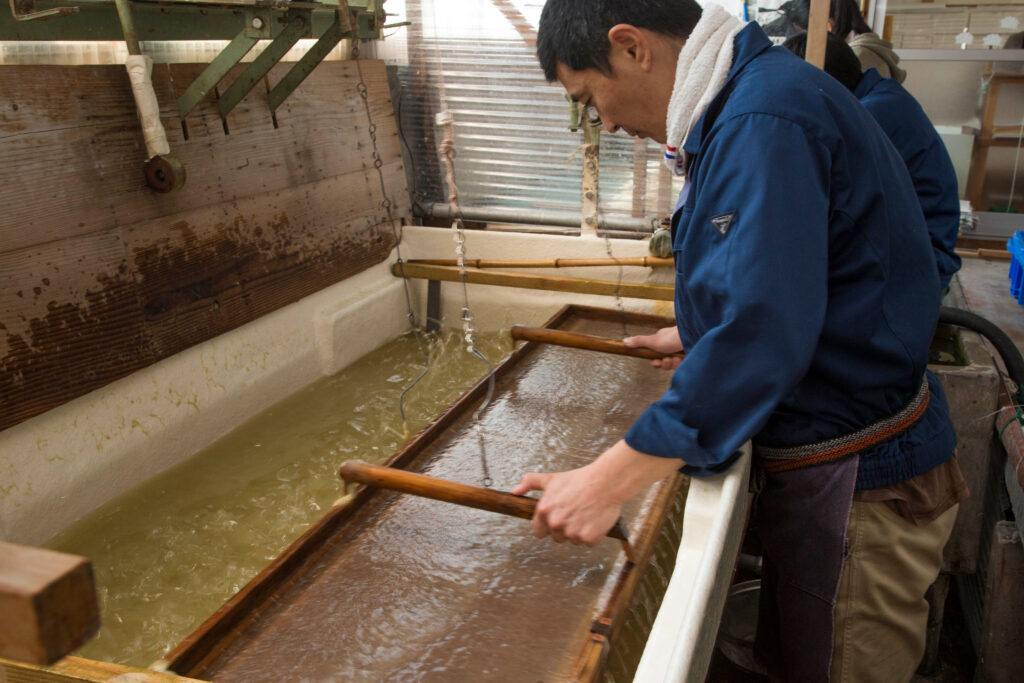
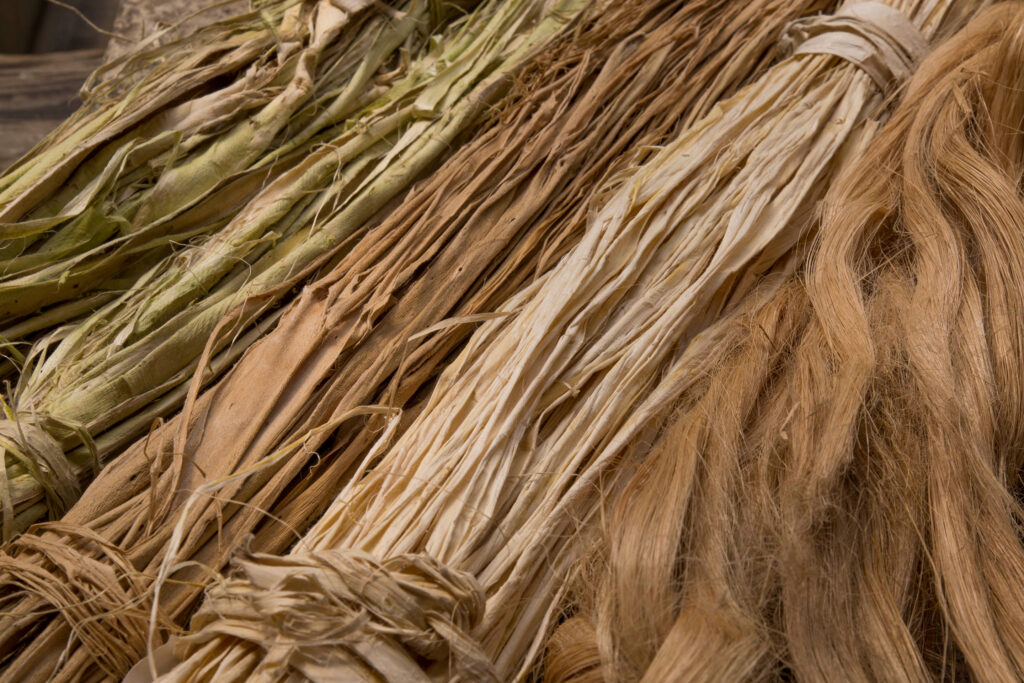
PRICE LIST OF HANDMADE ISEWASHI
(JAPANESE YEN NOT INCLUDING VAT)
| Packaged paper One edge not trimmed | Sarasi Kouzo | Misarasi Kouzo | Tyoumou Kouzo | Itabari Hanzousi | Oonaosi | Pure Mitumata | Huga | Husyo | Pure Ganpi | Measurements (mm) | |||
| Size | Thickness | sheets | Width | Length | |||||||||
| A4 | Single weight | 8 | 1,300 | 1,500 | 1,800 | 2,100 | 1,200 | 2,200 | 3,100 | 1,900 | 3,100 | 210 | 297 |
| A4 | Double weight | 2 | 700 | 800 | 650 | 1,150 | 1,600 | 1,000 | 1,600 | ||||
| 8 | 2,500 | 2,900 | 2,300 | 4,300 | 6,100 | 3,700 | 6,100 | ||||||
| A3+ | Double weight | 4 | 3,200 | 3,600 | 2,600 | 5,000 | 7,200 | 4,400 | 7,200 | 330 | 483 | ||
Single weight
Single weight has around 110 µm thickness.
| Whole sheet of paper Edges not trimmed | Sarasi Kouzo | Misarasi Kouzo | Tyoumou Kouzo | Itabari Hanzousi | Oonaosi | Pure Mitumata | Huga | Husyo | Pure Ganpi | Measurements (mm) | ||
| Size | sheets | Width | Length | |||||||||
| Housyo | 1 | 400 | 450 | 480 | 390 | |||||||
| Kessok | 1 | 700 | 800 | 950 | 750 | 360 | ||||||
| Kiku (smaller) | 1 | 1,200 | 1,400 | 1,700 | 2,000 | 930 | 620 | |||||
| Kiku (bigger) | 1 | 1,100 | 2,100 | 3,000 | 1,800 | 3,000 | 970 | 630 | ||||
Double weight
Double weight has around 220 µm.
| Whole sheet of paper Edges not trimmed | Sarasi Kouzo | Misarasi Kouzo | Oonaosi | Pure Mitumata | Huga | Husyo | Pure Ganpi | Measurements (mm) | ||
| Size | sheets | Width | Length | |||||||
| Kiku (smaller) | 1 | 2,400 | 2,800 | 930 | 620 | |||||
| Kiku (bigger) | 1 | 2,200 | 4,200 | 6,000 | 3,600 | 6,000 | 970 | 630 | ||
| Ren’oti | 1 | 3,200 | 3,600 | 2,600 | 5,000 | 7,200 | 4,400 | 7,200 | 1350 | 540 |
| KogutiZyouhuk | 1 | 3,600 | 4,000 | 3,000 | 8,000 | 4,800 | 1510 | 540 | ||
| Sihati | 1 | 18,000 | 20,000 | 16,000 | 50,000 | 28,000 | 1110 | 2424 | ||
| Sarasi Kouzo | Kouzo (100%) | One of the most standard handmade IseWashi. Bleached paper. |
| Misarasi Kouzo | Kouzo (100%) | The origin of washi that has natural color. Unbleached paper. |
| Tyoumou Kouzo | Kouzo (100%) | Made with long fibers only and the sheet has unique texture. Bleached paper. |
| Itabari Hanzousi | Kouzo : Mitumata = 2 : 1 | Mixed with Strong Kouzo and precise Mitumata fibers. |
| Oonaosi | Kouzo : Basewo = 1 : 2 | Mixed with Strong Kouzo and fine Basewo fibers. |
| Pure Mitumata | Mitumata (100%) | Thin and beautiful fibers can make fine grained luster paper. |
| Huga | Kouzo : Ganpi = 1 : 1 | Mixed with luster Ganpi and strong Kouzo fabers. |
| Husyo | Ganpi : Basewo = 1 : 1 | Mixed with luster Ganpi and fine Basewo fibers. |
| Pure Ganpi | Ganpi (100%) | Precise and luster fibers can make very smooth paper. |
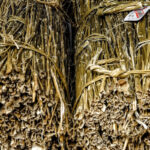
KOUZO
Deciduous tree, kind of mulberry.
The long and strong fibers are most popular materials for washi.
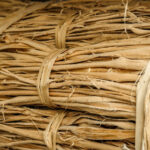
MITUMATA
Deciduous tree, kind of daphne.
Thin and beautiful fibers can make fine grained luster paper.
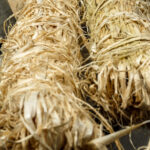
GANPI
Deciduous tree, kind of daphne. Hard to cultivate.
Precise and luster fibers can make very smooth paper.
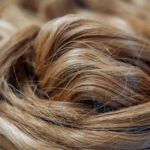
BASEWO
Perennial plant, kind of plantain.
Strong fibers from leaf sheath can make paper for minute expression.
Purveyor to Ise Jingu / Traditional craft of Mie pref.
TAIHOU WASI KOUGYOU K.K.
10-30, O'seko 1-chome, Ise Mie 516-0079, Japan
©伊勢和紙|isewashi

